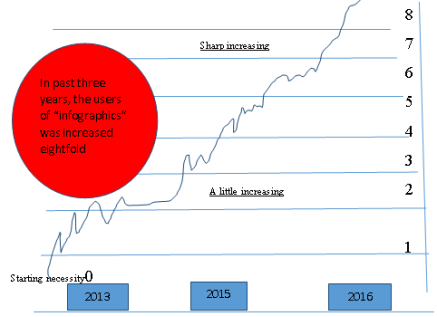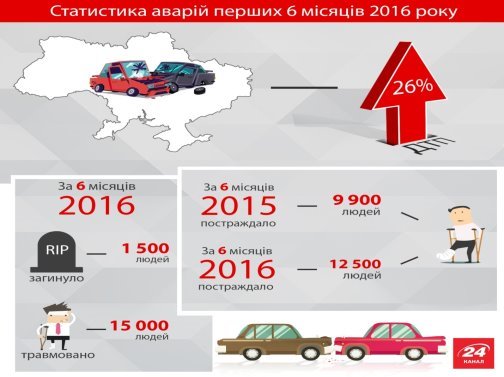The fast developing of our century has reverbated every part of writing. Journalism can also combine with any other professions like: economy, business, study, technic and shows its influence. In ancient times the history was drawn on walls, rocks but now it becomes a real profession and considered as fourth power of country. Working with information demand supreme skills and thoroughly handling.
There are many types of journalism: tv, radio, internet, writing form. Despite of types variation there is only one purpose. You can be tv or radio host, or a writer. They collect and then present the information. Now we want to introduce you with fast-developing type of journalism – infojournalism. In many cases was shown in internet by bright visual effects and light perception to audience. The applied genre of journalism is infographics, longrid, time-line, story-maps. Also we can include data-journalism as infojournalism because of its speed.
Key words: infographics, visualization, datajournalism, longread, statistics, portrait
Что такое журналистика? Ответ для нас очевиден, – это писать статьи, вести репортажи, проще говоря, доставлять информацию общественности. Но так ли это на самом деле? Оказывается, все намного сложнее, но не менее интересно. Новости, которые доходят до нас, – это тщательно обработанная информация.
В этой статье журналистика рассматривается под микроскопом, автор расщепляет свой объект на атомы для того, чтобы мы могли увидеть все воочию и воспринять эту информацию глазами журналиста. Мы познакомимся с разными жанрами «искусства пера», узнаем по каким критериям отбирается информация и какие средства помогают журналисту в написании статьи. Здесь также перечислены требования, которым должен соответствовать каждый журналист. Как же все-таки появилась нужда в журналистике и как эта профессия развивалась и давала плоды, мы узнаем в этой статье.
Ключевые слова: инфографика, визуализация, датажурналистика, лонгрид, статистика, портрет
The fast developing of our century has reverbated every part of writing. Journalism can also combine with any other professions like: economy, business, study, technic and shows its influence. In ancient times the history was drawn on walls, rocks but now it becomes a real profession and considered as fourth power of country. Working with information demand supreme skills and thoroughly handling.
There are many types of journalism: tv, radio, internet, writing form. Despite of types variation there is only one purpose. You can be tv or radio host, or a writer. They collect and then present the information.
Now we want to introduce you with fast-developing type of journalism — infojournalism. In many cases was shown in internet by bright visual effects and light perception to audience. The applied genre of journalism is infographics, longrid, time-line, story-maps. Also we can include data-journalism as infojournalism because of its speed.
There were so many accidents in past ten years so we couldn’t count them in one day. By statistics of 19 century there were only 10–20 news in a day, but it was enough. By now it is about 1000–3000 of any types of information in a day including daily news, talks, meetings and any other forms.
For present hard days the best suitable is infojournalism it can be shown by graphics, pictures, statistics and it gives results.
If someone wants to work in this sphere, he (she) should make out in design, economics, mathematics, drawings.
Infographics — info (latin) means explanation, graphics (greek) means writing — easy fast and unusual way of presentation. Firstly it was used In USA in 1982–1983 and shown in «USA Today» magazine. The presentation consists of graphics, statistics and information. Americans understood that it was very easy way of describing information [1].
Infographics is divided into two parts:
− applied in economy financial and business sphere;
− journalistic infographics.
The first is limited by economy financial qualificated people. It is narrow in exploiting.
The second form is wide in using,you need numbers statistics and graphics to show information.
The example of infographics:

Fig. 1.
In past 2015–2016 years was included to design as one of its type. It was presented by Edward Tafte in scientific way. In opinion of this scientist it is the best way of presenting the information without unnecessary and spare details.
Example of infographics that was made by designer:

Fig. 2.
You can make a presentation with the help of Flash, SVG programmes. There are many ways of showing infographics: by diagrams info-maps pictogrammes gistogrammes.The next wide using type of data-journalism is Longrid. The long rid users made it popular by its simple ways of delivering news to audience. Longrid is also strongly connected with info journalism.
For example if you want to write a Longrid article you will also use infographics extra information and details.
Longrid articles demand full information. And you should introduce audience with any details any people (even if he (she) is not so important). You should full your article with pictures infographics videos presentations. Now we should stop on different genres of Longrid.
Reportage is a very famous for us. For this genre is unnecessary to write about your opinion only facts numbers and etc. [2]
Reconstructive Longrid. The main purpose of reconstructive Longrid is prediction. You must give full information about some problems and give suggestions about further condition. And also full it with pictures videos.
Portrait Longrid.
You should write a portrait article with the help of interwies scetch-books biography. In this janre you should fully describe the biography of somebody.
The main rules of Longrid:
− Wide and full opinion;
− Fairly analyzed information;
− Unnecessary information that makes boring your article;
− Fresh and consummate news;
− You should use only your opinion.
The longest Longrid-article was written by Indonesian immigrants, it was 10500 words.
In the end we should remember:
That any news must be fully and truelly written. Alternatively your article will be boring and will intrest the audience.
References:
- MetthewRicketson. Writing feature stories: How to research and write newspaper articles. Unvin 2014.
- Вейлер К., Мауер Р. И. Сетевые СМИ – другая журналистика. Пер. С англ. //http://www.mediasprur.ru/jour/theorie/
- Калмыков А. А., Коханова Л. А. Интернет-журналистика. Учебное пособие. М.: ЮНИТИ-ДАНА, 2005.
- http://ru.wikipedia.org

